Visiting the Grand Canyon in September is a great time to visit. September is a busy time to visit but the crowds are starting to arrive especially toward the end of the month.
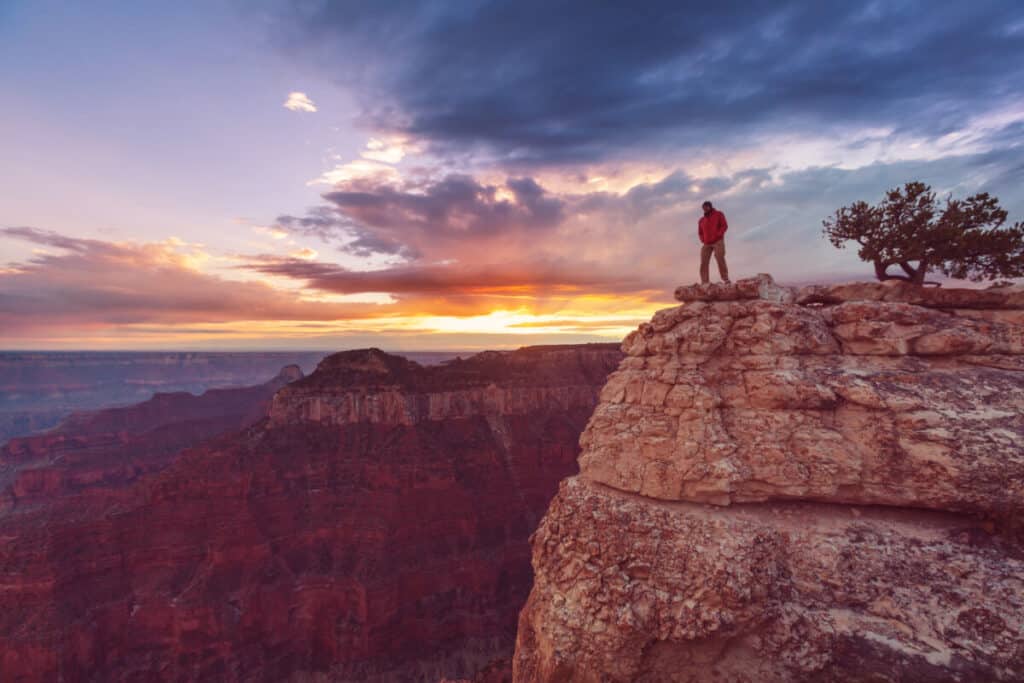
I’ve included all of the things to do in the Grand Canyon in September and tips and tricks for visiting. You can also use the Grand Canyon self guided tour to learn more about the Grand Canyon when you visit.
Weather in the Grand Canyon in September
In September, the daytime maximum temperature is 96 degrees Fahrenheit (29 degrees Celsius), while the overnight minimum is 68 degrees Fahrenheit (19 degrees Celsius). The Grand Canyon covers a huge area and each section has a varied temperature.
Thank you for supporting this website written by an American. This post may contain affiliate links. This means I earn a small commission on these links at no extra cost to you.
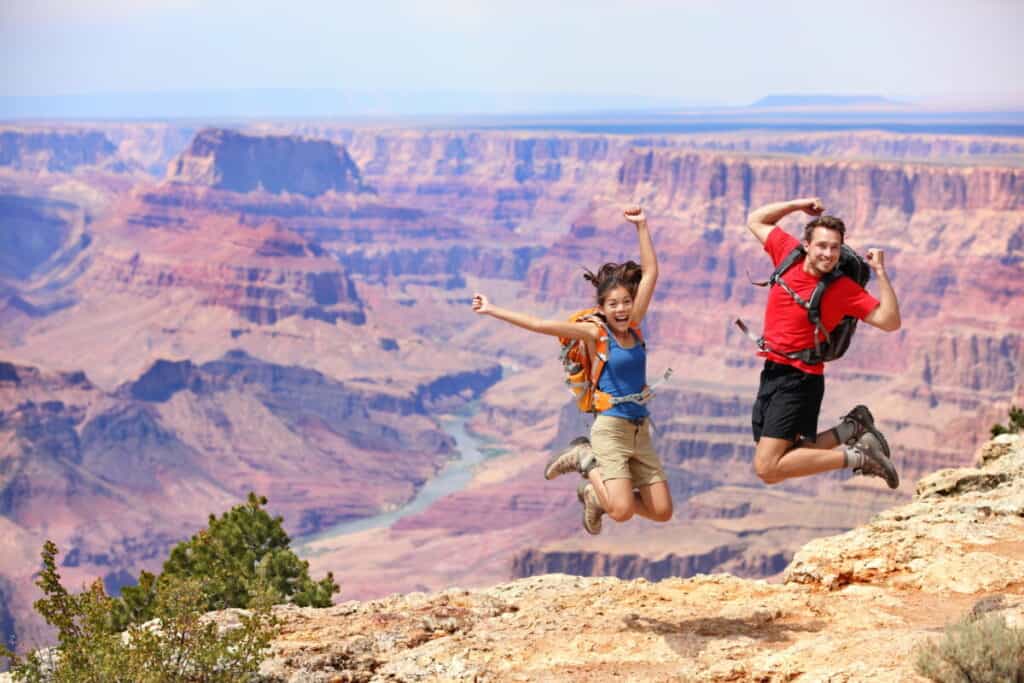
National Park Entrance Fees
To enter the National Parks, you’ll need to pay an entrance fee or have a National Parks Pass also known as American the Beautiful Pass.
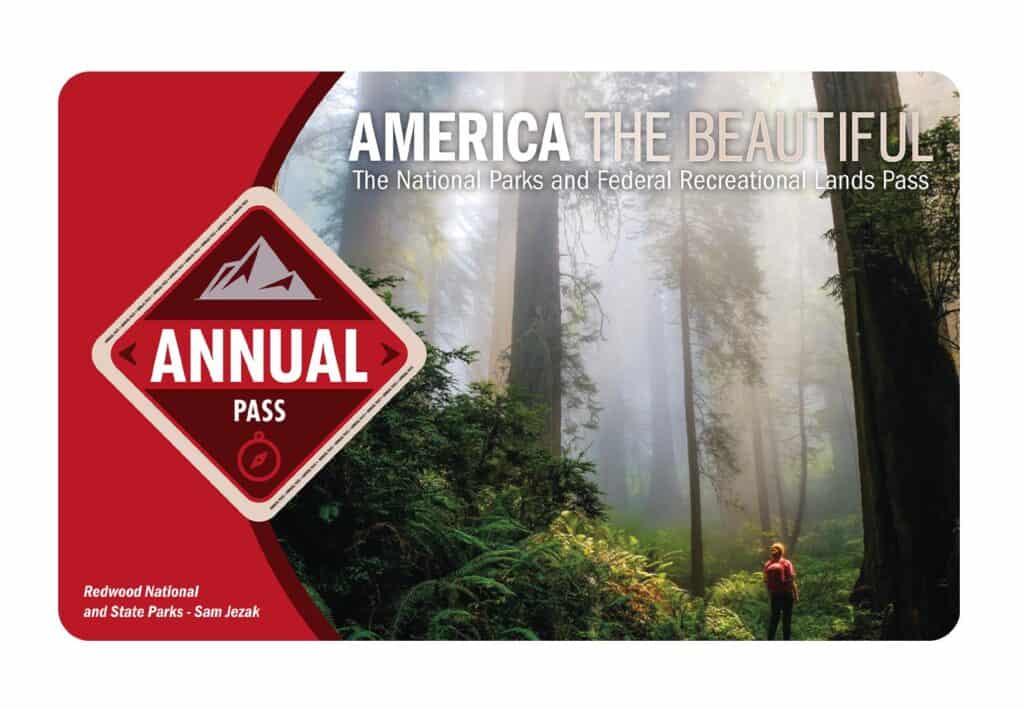
It costs $80 for a yearly America the Beautiful Pass. This gives you access to all national parks and federal areas that charge fees. The America the Beautiful Pass is well worth it!
I purchased my first one in 2016 and it’s such a money-saver! Plus 10% of sale proceeds go to the National Park Foundation.
Tips for Visiting Grand Teton National Park
Grand Canyon National Park is perfect for outdoor enthusiasts. There is something for everyone on this list and for different fitness levels. Also, note that it is dry and hot (in the summer), and make sure you know what you are getting into before you start. Here are a few tips for visiting the Grand Canyon:
- Bring a reusable water bottle and lots of water! Remember you are in the sun and you will need to drink lots of water. I love my LifeStraw Filtered Water Bottle. I can refill this bottle anywhere and it comes with a carabiner to connect it to my daypack.
- Check the Weather – days over 100 degrees are very common. Make sure to check.
- Hiking boots or sandals that will protect your feet! I love good shoes. I need all the support and help I can get. I actually love these sandals for hiking and also love these hiking boots.
- Bring hiking poles for balance and to protect your knees. I know many experienced hikers (and even amateur ones) think that hiking poles are for old people who lose their balance. Actually, hiking poles can help when going down steep inclines or when scrambling over rocks. They are great to hike with even for the most experienced hiker.
- Wear a sunhat. I feel like this whole post is about how high you are in the mountains and how much closer you are to the sun but it is so true. At elevation, you are closer to the sun and more likely to burn. Wear sun protection such as a sun hat and sunscreen.
- Be aware of the wildlife. This is the Southwest and you will need to watch out for snakes and other wildlife such as moose or a bear. Please stay away from wildlife and do not feed them. I recommend carrying bear spray as well.
- Start Early – If you want to avoid the traffic and the heat you will need to start your hike early. That way it will be nice and cool and the smog will not affect you either.
- Leave no trace. If you are new to the concept of Leave No Trace it is all about preserving the environment to ensure it is in the same or better condition when you leave it. This means that you should stick to the trails and carry out everything that you carried in. This is a great explanation of the Leave No Trace principles!
- Water shoes are great for water hikes– If you don’t have a pair, I highly suggest it as they are affordable. I have an article on the pros and cons of several pairs of water shoes.
- Bring Bug Spray and a snack: Be sure to bring everything you need including a snack like a protein bar plus BUG SPRAY.
Where to stay near Grand Canyon National Park
The Grand Canyon makes for a great weekend escape. Fresh air, beautiful scenery and being in nature does a world of good for the soul. I recommend staying as close to the park as possible and even treating yourself with a cabin with a spa pool to relax at night.
- There are lots of fantastic Airbnbs near the Grand Canyon. I have made a list of the best airbnbs around the park wherever you decide to stay. You can also check out my post on Where to Stay near the Grand Canyon to find the perfect hotel for any budget.
If you are taking a road trip remember to reserve a car in advance using Discover Cars .
15 Things to do in the Grand Canyon in September
Grand Canyon South Rim: Self-Guided Tour
See a natural wonder of the world in person on this self-guided driving tour of the Grand Canyon’s South Rim.

This self-guided driving tour takes you to all the best vistas, hikes, and attractions along Grand Canyon’s South Rim and tells you the secret history behind this famous landscape. Walk the scenic South Rim Trail, catch a sunset at Mather Point, and much more.
Maricopa Point
The Grand Canyon’s edge is relatively narrow at Maricopa Point. While it continues much further below as a thin ridge between Horn Creek and the bigger Garden Creek.

This is the second stop on the West Rim Shuttlebus Tour (the Hermit’s Rest Route), with Trail view Overlook being the first.
There are no significant barriers between Maricopa and the river, and views of the Grand Canyon extend over 180 degrees from here. While most of the Bright Angel Trail is obscured by the Battleship formation, several miles of the Tonto Trail is visible as they wind past Horn Creek and Dana Butte and down Garden Creek.
The ruins of Orphan Mine, which was established in 1893 as a source of copper, silver, and vanadium before finding its greatest importance as a uranium mine from 1956 to 1969, when for a period it was the richest source in the entire US, are located just west of Maricopa Point.
The once-short walk west to the next overlook, Powell Point, has been extended by half a mile due to the closure of a stretch of the rim trail past the spoil heaps and its diversion around the perimeter fence due to concerns about radioactive contamination.
The winch engine and a few derelict structures are located at the brink of the canyon; the actual shafts and tunnels were located 1,000 feet below that, in a mineralized area of the Coconino sandstone layer.
Drive Hermit Road
Some of the best perspectives and overlooks in Grand Canyon National Park may be found on Hermit Road, which is on the West Rim. From March 1 to November 30, only the park shuttle can access the road (red line).

Hermit Road is 7 miles long, and depending on how many stops you make, it will take you between 15 and 20 minutes to drive each way. Hermits Rest, an excellent place to stop and admire the breathtaking vistas, is located at the end of Hermit Road.
Trail View Overlook, Maricopa Point, Powell Point, Hopi Point, Mohave Point, Monument Creek Vista, Pima Point, and Hermits Rest are a few of the Grand Canyon vistas along Hermit Road.
See Ooh Aah Point
One of the Grand Canyon’s greatest views, Ooh Aah Point, has a catchy and appropriate name. As the views are from inside the canyon itself, they are unlike any others in the park and offer expansive panoramic panoramas.

It takes some work to get to Ooh Aah Point, and it takes approximately twice as much work to go back because it’s all uphill. The point itself is situated 600 feet below the canyon rim.9 miles down the South Kaibab Trail from the trailhead. A wooden sign identifies the obvious location.
Bright Angel Trail
One of the best and most well-known trails in the entire world, the Bright Angel Trail is the pinnacle of Grand Canyon trails. Everyone’s list of the top things to do at the Grand Canyon should include hiking at least a little bit of this trail.
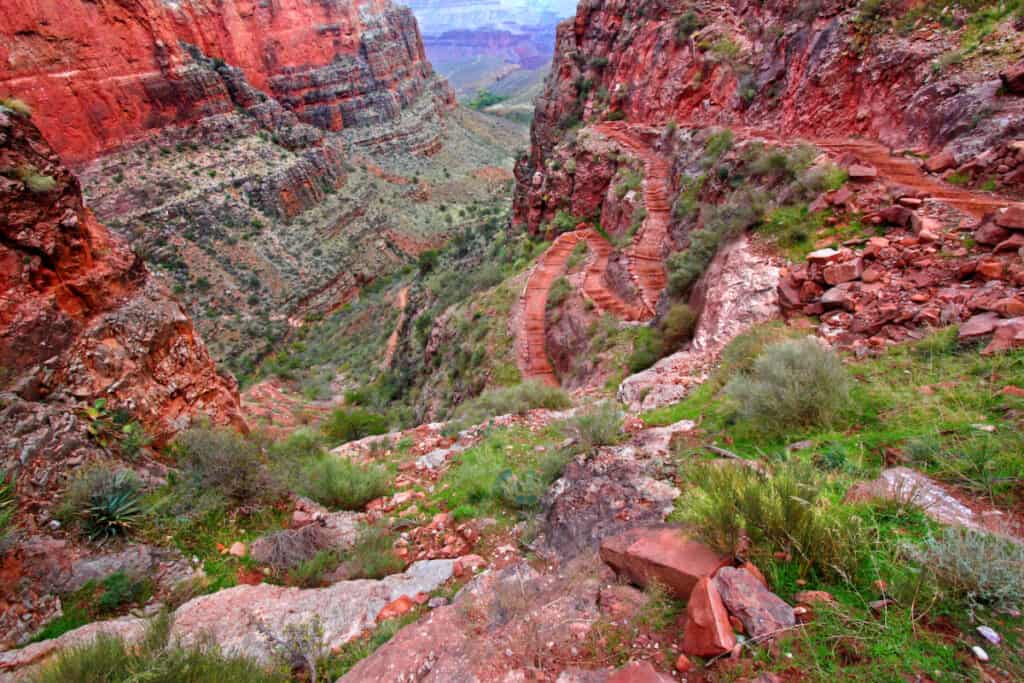
The trail is 8 miles long (almost 10 miles to Phantom Ranch) and rises by an incredible 4,380 feet on each leg. For comparison, that is considerably higher than two One World Trade Centers!
Any extended (or not-so-extended) stretch of this trail requires hard work and prudence when hiking. The descent is deceptively simple, but the ascent can be difficult. At the 1.5-mile and 3-mile rest stops, as well as Indian Gardens, which is essentially halfway to the Colorado River, there are water fountains.
The first few miles of Bright Angel offer a more constrained view of the canyon, though it is still breathtaking, in contrast to the South Kaibab Trail, which offers expansive, panoramic views. The good news is that the trail offers hikers protection from the sun by being sheltered in the morning and the late afternoon.
When hiking Bright Angel, keep in mind that every step down must be followed by an upward step. A good rule of thumb is that you should allow at least twice as much time for the trip up as you would for the hike down.
Trail of Time Walk
One of the most fantastic interactive activities in the Grand Canyon is named The Trail of Time, which allows you to fully comprehend the canyon’s incredible development over billions of years. The fully accessible, paved walk begins directly beside the Yavapai Geology Museum.
The first 150 yards or so of the trail span a period of a million years. The second section, which is about 2.8 miles long, takes you through 2 billion years of history. On the second section of the trail, each meter corresponds to one million years in the Grand Canyon’s geologic history.
You can get sweeping vistas of the canyon while hiking the trail, which lasts around an hour.
Watch the Grand Canyon IMAX Film
Watching the magnificent Grand Canyon IMAX Movie is one of the best things to do at the Grand Canyon for people searching for some air conditioning and relaxation.
Although the theater is technically outside the park, it’s a terrific addition for families and individuals searching for a little more knowledge and appreciation of the Grand Canyon. It’s located about 10 miles (15 minutes) south of the South Entrance in Tusayan.
Tusayan Ruin
For those who are interested in culture and history, seeing the Tusayan Ruin is a wonderful addition to your list of things to do at Grand Canyon National Park East. The Grand Canyon is home to more than 4000 recognized archeological sites, some of which date back as far as 12,000 years!
Only the base of the structure that took place here is still visible today, but it serves as a fantastic entry point for visitors of all ages to learn about the park’s rich cultural heritage. There may have been 16 to 20 residents in this little town.
While you’re in the area, visit the Tusayan Museum for more fascinating information that will help you make connections regarding these remarkable people.
It is conveniently placed just off Desert View Drive, 3.4 miles (and 7 minutes drive) away from the Desert View complex.
Ride a mule into the Grand Canyon
Riding a mule down into the canyon proper, or perhaps to the bottom if you’re willing, is one of the Grand Canyon’s most daring activities. At both the South Rim and the North Rim, there are concessionaires offering mules rides.
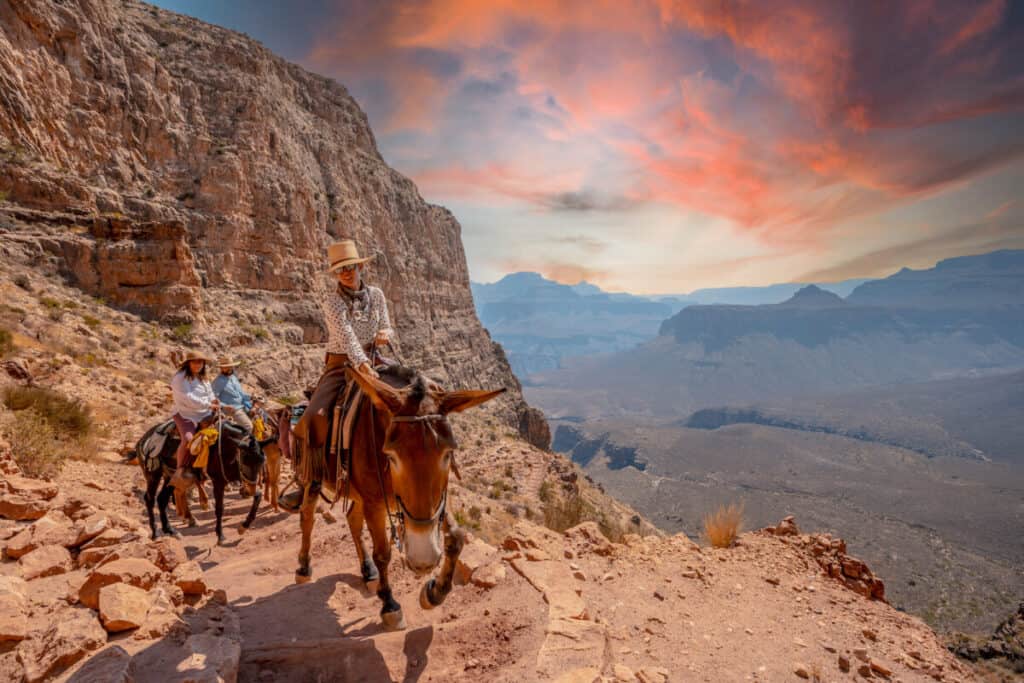
Although the outrageous cost of the overnight mule ride may make your wallet shake, those who are intrigued should realize that it does include overnight accommodations at Phantom Ranch (located at the foot of the canyon), sack lunches, a steak dinner, and breakfast.
Although none of these rides take you to the bottom of the canyon for an overnight trip, they are all significantly less expensive than the ones provided by Xanterra on the more well-known South Rim.
Hopi Point
You will go east from Grand Canyon Village to start the legendary Hermit’s Road Drive. A wonderful woodland road leads to numerous viewpoint points and viewing spots as it leaves the rim.
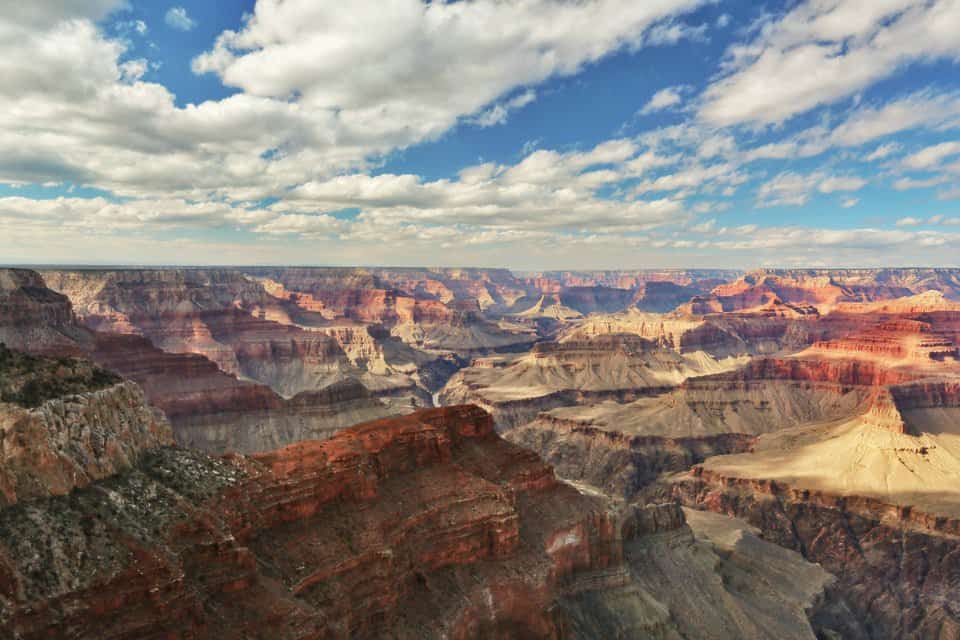
One of the most breathtaking perspective sites along Hermit’s Road Drive is at Hopi Point, which is roughly two miles away. This popular canyon overlook position gives stunning views of the canyon walls right next to it and one of the five initial sightings of the river to the west.
In addition, Hopi Point offers some of the best views of Grand Canyon sunsets because of its elevated location. To truly appreciate how the sun illuminates the canyon, you’ve got to visit it!
Grand Canyon and Valley of Fire Helicopter Champagne Landing Tour
A breathtaking flight above the Grand Canyon and a stop at Valley of Fire State Park are both included in this helicopter tour. The adventure lasts about four hours and includes transportation back and forth from most hotels in Las Vegas.
Before landing at the state park for a Champagne toast and the opportunity to take pictures of the red Aztec sandstone outcrops, you’ll get to take in vistas of the Hoover Dam, the Mojave Desert, and the Grand Canyon throughout the 100-minute trip.
Your knowledgeable pilot will provide live narration as you travel, which is a highlight for reviewers who value the pilot’s explanation of the park’s numerous geological features.
Every day in the afternoon, flights with prices starting at $599 per person are available (exact departure varies by month). Consider taking one of 5 Star’s Las Vegas flightseeing tours for a birds-eye perspective of the Strip.
Mohave Point
The 3,000-foot-high, nearly vertical cliffs that surround The Abyss and stretch two miles to the west, towards Pima Point, may be seen well from Mohave Point.

Three of the following points are beyond, further to the west, and they are getting smaller and smaller. At the end of Monument Creek, which takes up most of the nearby terrain, around half a mile of river, including Boucher Rapids and Granite Rapids, is visible beneath the enormous cliffs.
The view starts with Bright Angel Canyon on the North Rim and includes Ninety-one Mile Creek, Trinity Creek, and Ninety-four Mile Creek because the ridge stretching from Hopi Point blocks some of the canyons in the east. The Red Mesa, a striking red sandstone mesa with sharp edges, is located just behind Mohave Point.
Together with Hopi Point, Mohave is one of only two eastbound stops on the Hermit’s Rest shuttle bus route, and both are well-known spots to see the setting sun. Hopi offers more panoramic views, but Mohave offers multiple overlooks rather than just one, has smaller tourist traffic, and is therefore generally more tranquil.
Abyss
The Abyss doesn’t stick out into the canyon like some of the other picturesque vantage points along Hermit Road. The Abyss, on the other hand, is a steep, notched, or hollow indentation in the canyon walls that plunges precipitously almost 3,000 feet into the Grand Canyon to the Redwall Formation.
This picturesque vantage point in Grand Canyon National Park provides views of Monument Creek, the Tonto Plateau, the Colorado River, Granite Rapids, and the Monument, a sizable sandstone column in the Grand Canyon, in addition to a slightly frightful, steep, vertical view down the canyon into the Monument Creek drainage area.
Helicopter Ride down into the Grand Canyon
At the Grand Canyon, helicopter tours are accessible all year long. You should experience the vistas of the canyon covered with snow in December.
Even though there are many excursions available, the Grand Canyon Helicopter Tour is among the best. During the 45-minute flight, you will fly over the South Rim and the Kaibab National Forest.
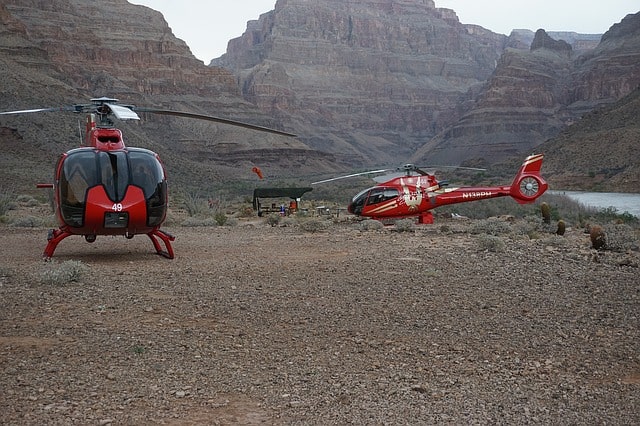
Experience the canyons by looking down into them on a helicopter tour or simply viewing them from a vantage point.
These helicopter rides, though perhaps a bit pricy, are well worth it and will provide you with priceless memories.
Experience the Spirit Helicopter Tour if you want to make this a trip you’ll never forget. The most popular and affordable helicopter tour leaving from the South Rim is this one.
The Spirit Tour, which flies over the Painted Desert, Kaibab National Forest, and—best of all—the Dragon Corridor, the widest and deepest section of the Grand Canyon, gives you some of the best sights, making this experience particularly wonderful.
Yavapai Point
Looking for Lake Pleasant’s best vista? Yavapai Point is reached through the Pipeline Canyon Trail, which provides a magnificent experience along the way as well as an amazing 360-degree panorama from the peak.
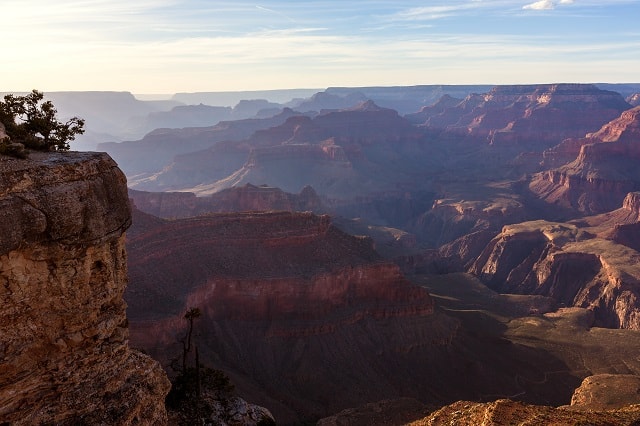
You won’t be dissatisfied with the variety of routes or the flora and fauna, which range from wider, well-maintained trails across Pipeline to narrower, steeper areas on Yavapai Point. Mexican gold poppies, desert globemallow, and brittlebush are common springtime plants. Additionally, watch out for burros! They can be wandering the nearby hills or on the trail.
To start this hike, park in the Cottonwood Day Use Area parking lot, which is located close to Cottonwood Lane on the west side of Lake Pleasant. On Pipeline Canyon Trail, turn south from this point. Tall signs identify the trailhead and any forks in the route.
When the Pipeline Canyon Trail and the Cottonwood Trail converge, turn left to stay on Pipeline. Following Pipeline will lead you up the slope on the left, through a little wash, and to the next junction. At the next junction, you can choose to continue on Pipeline or turn left to begin the ascent to Yavapai Point.
Although there are some breathtaking views of springtime poppies as you travel further down Pipeline Canyon, Yavapai Point offers the best vantage point.
The trail gets narrower, a little bit rockier, and steeper as it ascends Yavapai Point. Switchbacks, which help to lessen the steepness, swiftly replace the straight section. This short quarter-mile portion is well worth the effort. When you reach Yavapai Point’s peak, you can see Peak 3465 to the west, as well as Hell’s Canyon, Baldy Mountain, and other mountains. North Phoenix will be to the southeast and the Bradshaw Mountains to the north. Naturally, Lake Pleasant is visible to the east.
Take a minute to unwind and take in the scenery if the bench at the top is available. Before you go back down the route, it is a good time for a quick lunch and some water.
Hermit’s Rest
At the westernmost point of the south rim is Hermit Road, a well-known 7-mile route that starts at Hermit’s Rest and proceeds through numerous picturesque viewpoints.
There are shuttle buses that run by the Grand Canyon along this route. The highway can also be used by private vehicles.
Some of the best views of the canyon may be seen along this road, including those from Hopi Point, Mohave Point, and Pima Point.
Recent Posts
15 Tips for Visiting the Grand Canyon in August – 2023 Ultimate Guide
Visiting the Grand Canyon in August is a great time to visit. August is a busy time to visit but the crowds are starting to arrive especially toward the end of the month. I’ve included all...
15 Tips for Visiting the Grand Canyon in July – 2024 Ultimate Guide
Visiting the Grand Canyon in July is a great time to visit. July is a busy time to visit but the crowds are starting to arrive especially toward the end of the month. I’ve included all of...
